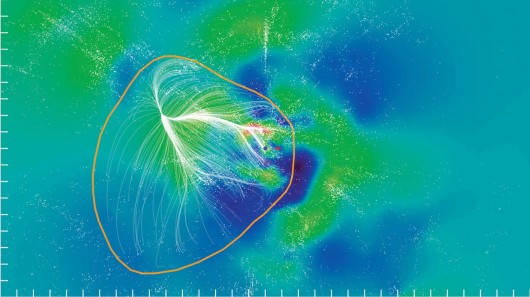
The Laniakea Supercluster, to which our Milky Way belongs, shown in the supergalactic equatorial plane (Image: CEA/Saclay, France)
A new study has revealed that our Milky Way is a member of a group of local galaxies interconnected within a larger supercluster made up of a myriad of other galaxies, all intertlinked by a tenuous web of filaments many thousands of light years long. Dubbed "Laniakea" (Hawaiian for "immense sky") by astronomers working at the National Science Foundation’s (NSF's) Green Bank Telescope (GBT) and others around the world, this research defines hitherto unknown boundaries and connections in our corner of the universe.
Using the NSF’s Green Bank Telescope and other radio telescopes dotted around the planet, astronomers from the University of Hawaii leading an international group of scientists have mapped the velocities of galaxies surrounding us in our local universe, allowing them to determine the region of space where superclusters dominate.
"We have finally established the contours that define the supercluster of galaxies we can call home," said R. Brent Tully, an astronomer at the University of Hawaii at Manoa. "This is not unlike finding out for the first time that your hometown is actually part of much larger country that borders other nations."
Amongst the largest structures in the known universe, superclusters are made up of groups, containing dozens of galaxies, and massive clusters that contain hundreds of other galaxies. The Laniakea Supercluster that the Milky Way is part of is some 500 million light-years in diameter and contains an incredible one hundred million billion suns extending across 100,000 galaxies.
Within the confines of the Laniakea Supercluster, galactic motions are focused inward as matter cascades in to the center over many thousands of millennia. The region at the center of the structure causing this inward attraction is a large flat gravitational basin with a domain of attraction that spreads across the entire Supercluster.
Another gravitational pivot point in intergalactic space that affects the motion of our galaxy – and the supercluster containing it – is known as the Great Attractor. This will also be studied in greater detail as astronomers continue to map out and capture more details on this part of the cosmos.
Translating velocities into a three-dimensional field of galactic movement and concentration will add further to our cosmological understanding of the universe and the influence that very large structures like superclusters have upon it.
The research was published in the journal Nature.
The short video below shows an animation of the forces and outline of the Laniakea Supercluster.
Source: University of Hawaii
Copyright © gizmag 2003 - 2014 To subscribe or visit go to: http://www.gizmag.com
http://www.gizmag.com/galactic-supercluster-milky-way-galaxy/33652/